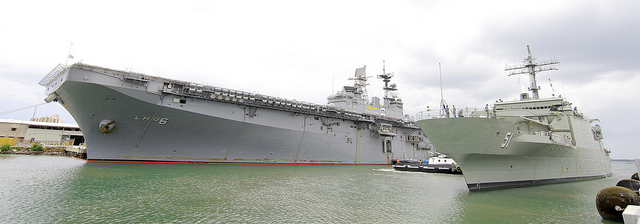DWP 2013—what will the Americans think?
Posted By Andrew Smith on May 6, 2013 @ 12:51
 [1]
[1]The Defence White Paper 2013, like most of its recent predecessors, emphasises the United States Alliance, even to the extent of capitalising ‘Alliance’ whenever used in relation to the US. The document counts no other countries as Australian allies, characterising different friends instead as ‘partners’—even New Zealand. Once it becomes aware of this (as I write this, 18 hours after the document’s release, it hasn’t broken on any of the sites I track here in the USA, despite it still being Friday) I have no doubt the US will be gratified by the relationship’s pre-eminence in Australia’s Defence policy. Those American policymakers who look particularly in Australia’s direction might have more nuanced reactions.
Americans will notice the attention paid to the American rebalance to the Asia-Pacific. Those closest to Pacific Command (the military Proconsulate responsible for that region) will probably welcome the White Paper’s use of the term ‘Indo-Pacific’ in contrast to ‘Asia-Pacific’. This is an example of Australia providing a regional perspective to common issues which many informed Americans appreciate, but are constrained from adding themselves for various institutional reasons. By raising the idea of an emerging Indian Ocean economic zone (distinct from the North Atlantic or Pacific Rim zones), the White Paper contributes usefully to discussion in the US, where geo-political orthodoxies can be hard for insiders to overturn.
But Americans will also notice the White Paper’s heavily regional focus. Notwithstanding the rebalance, the US has global interests and responsibilities from which it can’t resile and with which it will expect assistance from Allies, even junior ones like Australia. The contributions of the 60-nation ‘Coalition’ over the last dozen years to the various crises in the Middle East, Central and South Asia (Afghanistan, Iraq and piracy off the Horn of Africa) are examples of such assistance. But the convening power of those crises is waning and nations are heading for the exits—the White Paper devotes an entire chapter to ‘Drawdown from Major Operations’. Recent U.S. meetings with other allies—such as this week’s talks between Secretary of Defence Chuck Hagel and his UK counterpart Philip Hammond [2]—go to this issue, but the indications are that it will take a crisis (such as an exploding Iran or an imploding Syria) to get the international community back into ‘the Central Region’. The US would prefer to avoid crises.
The White Paper does a better job than the National Security Strategy of acknowledging Australia’s important global interests in the Middle East (energy security and the free flow of maritime commerce) and our growing investment interests in Africa. It makes a medium-term commitment to the development of Afghanistan, notes the potential need to support our Ally well outside our own region, and deftly leaves open the possibility of maintaining basing arrangements in the United Arab Emirates and our Naval commitments in the Gulf and off the Horn of Africa. These are prudent measures that will help the US ‘keep the Coalition warm’ in anticipation of the next inevitable crisis in or near the Middle East, and to that extent they’ll be appreciated.
But the White Paper might not be clear enough about the quantum of future Australian contributions outside the Indo-Pacific to satisfy a cash-strapped US wanting to share more of the burden of securing the global commons with other beneficiaries of that security. Australia shouldn’t presume that securing the Southwest Pacific will be considered a sufficient share of that burden—stability in that small sub-region could deteriorate totally without impacting US vital interests, while even a brief closure of the Straits of Hormuz would hurt America and Australia (and our important trading partners) significantly. The White Paper might underestimate the likelihood of another significant ‘extra-regional’ deployment, especially to the Middle East which is, after all, the western shoulder of the Indo-Pacific.
Americans might also be concerned with the White Paper’s slippery treatment of the preparedness dilemma (the trade-off between future investment and current capability). The several paragraphs devoted to this simply enumerate the considerations affecting preparedness decisions and don’t state where risk will be taken. In contrast, recent statements from the US Department of Defense [3] state clearly that capital investment will be maintained at the risk of ‘burning readiness’. This is more frank that the White Paper’s language, but also a more manageable approach for a force of the size of America’s. US planners might be looking for a less equivocal statement of Australia’s readiness intentions.
It’ll take some time for a considered American response to the White paper to emerge, but we should be waiting for it. Interested commentators, such as Richard Armitage, will have something to say about it (and the forthcoming Budget) and, given the importance attached to the Alliance, Australia should pay attention.
Andrew Smith is an independent researcher based in the United States. Image courtesy of Flickr user US Pacific Fleet [4].
Article printed from The Strategist: https://www.aspistrategist.org.au
URL to article: https://www.aspistrategist.org.au/dwp-2013-what-will-the-americans-think/
URLs in this post:
[1] Image: http://www.aspistrategist.org.au/wp-content/uploads/2013/05/4756099831_576d077f2e_z.jpg
[2] such as this week’s talks between Secretary of Defence Chuck Hagel and his UK counterpart Philip Hammond: http://www.defense.gov/transcripts/transcript.aspx?transcriptid=5231
[3] recent statements from the US Department of Defense: http://www.defense.gov/news/newsarticle.aspx?id=119747
[4] US Pacific Fleet: http://www.flickr.com/photos/compacflt/4756099831/
Click here to print.